Remedial Classes provides you NCERT Solutions for Class 10 Science Ch 5 intext questions on page no. - 81, 85, 90, and End exercise questions. We provide the best NCERT Solutions for Class 10 Science Ch 5 in both English and Hindi. For better preparation, you must solve MCQ questions and extra questions in chapter 5.
You can also download the PDF format of
NCERT Solutions for Class 10 Science Ch 5 for offline use. This solution is
very useful to those students who are using NCERT books 2021-22. NCERT
Solutions for Class 10 Science Ch 5 is based on the latest guidelines of the CBSE
board.
NCERT Solutions for Class 10 Science Ch
5 has been prepared by our expert teachers. Our only aim is to provide the best
educational content free of cost so that you can secure good marks in your
examinations
NCERT Solutions for Class
10 Science Ch 5covers
complete the syllabus and let you secure the best results in CBSE and other board
exams. NCERT Solutions for Class 10 Science Ch
5will help you to solve homework and home
assignments in an easy way.
NCERT Solutions for Class10 Science Ch 5
Before you study the NCERT Solutions For Class 10 Science Ch 5, you
should go through all the topics and
subtopic of Chapter 5 Periodic Classification of Elements of
NCERT Science for Class 10.
1.Making Order Out of Chaos- Early Attempts At The Classification of Elements
i.Dobereiner’s Traids
ii. Newlands’Law of Octaves
2.Making Order Out of Chaos- Mendeleev’s Periodic Table
i.Achievements of Mendeleev’s
Periodic Table
ii. Limitations of Mendeleev’s
Classification
3. Making Order Out of Chaos- The Modern Periodic Table
i.Position of Elements in the Modern
Periodic table
ii. Trends in the Modern Periodic
Table
Students of CBSE Board, RBSE, and other state boards of
Rajasthan, Uttar Pradesh, M.P., Gujrat, and all other states can download
Solutions of Chapter 5 Periodic Classification of Elements of
NCERT Science for Class 10 in English medium and Hindi medium in PDF format for
free.
You can also watch videos of Solutions of Chapter 5
Periodic Classification of Elements of NCERT Science for
Class 10 for online. The solution is based on the latest syllabus of CBSE 2021-22.
Table of contents
NCERT Solutions for Class 10 Science Ch 5 intext questions
Chapter 5
Periodic Classification of Elements
TEXTBOOK QUESTIONS:
Questions (Page 81)
Q.1Did Dobereiner’s triads also exist in columns
of Newlands’ Octaves? Compare and find out.
Ans. Yes, some of Dobereiner’s triads also existed in
columns of Newlands’ Octaves such as Li Na and K, Be, Mg, and 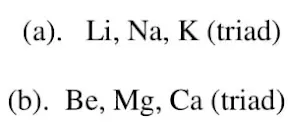
Q.2What were the limitations of Dobereiner’s
triads?
Ans. He could identify only three triads from the elements known at that time.
This system of classification was not found to be useful.
Q.3What were the limitations of Newland’ Law of
Octaves?
Ans. Limitations:-
1This law was applicable only up to calcium (atomic
mass 40).
2. After Ca every element every eighth did not show
similar properties to that of the first.
3. Newland assumed that only 56 elements exist in nature.
4. Newland adjusted two elements in the same slot.
5. He put elements in the same slot having different
properties e.g. - Co & Ni were placed with Cl, F which have different
properties from these.
6. He put elements having similar properties far away
from each other e.g. - Iron which resembles cobalt and nickel was placed far away
from them.
7. This law worked well with lighter elements.
Questions (Page
85)
Q.1Use Mendeleev’s
periodic table to predict the formulae for the oxides of the following elements K, C, Al, Si, Ba.
Ans.
|
Elements |
Formula of oxide |
|
K |
K2O |
|
C |
CO2 |
|
Al |
Al2O3 |
|
Si |
SiO2 |
|
Ba |
BaO |
Q.2Besides gallium, which other elements have since been discovered that fill the gaps left by
Mendeleev in his periodic table. (Any two)
Ans. Scandium and Germanium were the elements that
fill the gaps left by Mendeleev in his periodic table.
Q.3 What were the
criteria used by Mendeleev in creating his periodic law?
Ans. The following criteria were used by Mendeleev in creating his periodic law.
(i) Properties of elements.
(ii) Increasing order of their atomic masses.
Q.4Why do you think
the noble gases are placed in a separate group?
Ans. The noble gases (He, Ne, Ar, Kr, and Xe) are placed in a separate group because;
(i) Their properties do not resemble any other group.
(ii)They are inert and do not react with other elements.
Questions (Page 90)
Q.1How could the
Modern Periodic Table removes various anomalies of Mendeleev’s Periodic Table?
Ans. Mendeleev’s periodic table was based on atomic
mass but the modern periodic table is based on atomic number, In the modern periodic table,
limitations were removed in the following manner-
Q.2Name two elements
you would expect to show chemical reactions similar to magnesium. What is the
basis for your choice?
Ans. Electronic configuration of Mg is 2, 8, and 2,
so the other two elements which will show chemical reactions similar to magnesium should have 2 electrons in their outermost shell. So Ca (Z=20) and Sr (Z-=38) will
show properties similar to Mg because their electronic configuration is 2, 8,
8, 2 and 2, 8, 18, 8, 2 respectively, and they have 2 electrons in their
outermost shell.
Q.3Name:
(a)Three
elements that have a single electron in their outermost shells.
(b)Two
elements that have two electrons in their outermost shells.
(c)Three
elements with filled outermost shells.
Ans. (a)Hydrogen, lithium, and sodium are three
elements that have a single electron in their outermost shell.
(b)Magnesium and calcium two elements that
have two electrons in their outermost shell.
(c) Helium,
neon and argon are three elements with filled outermost shells.
Q.4 (a)Lithium, sodium, potassium are all
metals that react with water to liberate hydrogen gas. Is there any similarity
in the atoms of these elements?
(b) Helium is an unreactive gas and neon is a gas of extremely
low reactivity. What, if anything, do their atoms have in common?
Ans. (a) Lithium,
sodium, and potassium are metals that react with water to liberate hydrogen
gas. These elements have an electron in the outermost shell of their atoms.
The electronic configuration of these elements is given:
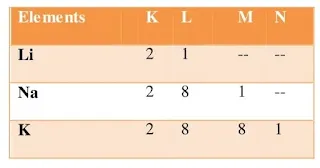
(a). 2Li + 2H2O →2LiOH +H2
(b).2Na + 2H2O → 2NaOH + H2
(c) 2K + 2H2O →2KOH + H2
(b) Helium is an unreactive gas and
neon is a gas of extremely low reactivity. Their atoms have filled the outermost shell.
Both the elements belong to group 18 or Zero group.
Q.5In the modern periodic table, which are the
metals among the first ten elements?
Ans. In the modern periodic table, the metals among
the first ten elements are Li and Be.
Q.6By considering
their position in the periodic table, which one of the following elements would
you expect to have maximum metallic characteristics?
Ga Ge
As Se Br.
Ans. Ga has the maximum
metallic characteristics.
Metallic
character decreases on moving from left to right in a period and increases on
moving down in a group, so out of the above elements, Be and Ga is the most
metallic. Out of both of them, Ga is bigger in size so it has a greater tendency
to lose electrons than Be. So Ga is more metallic than Be.
End Exercise Questions
Q.1Which of the
following statements is not a correct statement about the trends when going
from left to right across the periodic table.
(a)The
elements become less metallic in nature.
(b)The
number of valence electrons increases.
(c) The
atoms lose their electrons more easily.
(d) The oxides lose their electrons more easily.
Ans. (c) The
atoms lose their electrons more easily.
Q.2 Element X forms a
chloride with the formula XCl2, which is solid with a high melting
point. X would most likely be in the same group of the periodic table as
(a) Na (b)Mg
(c)Al (d) Si
Ans. (b) Mg
Q.3 Which element
has?
(a)Two
shells, both of which are completely filled with electrons?
(b)The
electronic configuration 2, 8, 2?
(c) A
total of three shells, with four electrons in its valence shell?
(d) A total of two shells, with three electrons in its valence shell?
(e)Twice as many electrons in its second shell as in its first
shell?
Ans. (a) Ne (b)Mg
(c) Si (d)B
Q.4(a) What property do all elements is the same
column of the periodic table as boron have in common?
(b)What property do all elements in the same column of the periodic table as fluorine have in common?
(a)Boron is present in the 13th group of the periodic table. All elements of this column have 3 electrons in their valence shell. The other member of the column is Aluminium, indium, etc.
(b) Fluorine is present in the 17th Group of the periodic table. All members of this group like Chlorine, Bromine, Iodine, etc. have seven
electrons in their valence shell.
Q.5An atom has
electronic configuration 2, 8, 7.
(a)What
is the atomic number of this element?
(b) To which of the following elements would it be chemically similar?
(Atomic numbers are given in parentheses.
N(7), F(9), P(15), Ar(18).
Ans.(a)Atomic
number of element is 2 + 8 + 7 = 17.
(b)It
would be chemically similar to F.
Q.6 The position of
three elements A, B, and C in the periodic table are shown below:
(a) State whether A is a metal or non-metal.
(b) State whether C is more reactive or less
reactive than A.
(c) Will C be larger or smaller in size than B?
(d) Which type of ion, cation or anion, will be
formed by element A?
Ans. (a)A is non-metal.Reason. Group 17 represents the halogen family all elements are non-metals
(b)C is more reactive than A.
(c) C
is smaller in size than B.
(d) Element
A will form an anion.
Q.7 Nitrogen (atomic
number 7) and phosphorus (atomic number 15) belong to group 15 of the periodic
table. Write the electronic configuration of these two elements. Which of these
will be more electronegative? Why?
Ans.
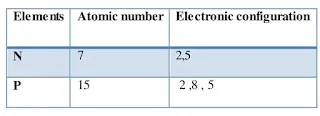
Nitrogen is more electronegative than phosphorus
because electronegativity decreases down the group.
Q.8How does the
electronic configuration of an atom relate to its position in the modern
periodic table?
Ans.The modern periodic table is based on electronic
configuration of elements. Electrons in the outermost shell show the group
number and the number of the outermost shell show the period to which the element
belongs.
For example, all the alkali metals have one electron each in their valence shell and
are placed in Group 1.
For
example, if
electronic configuration of an element is 2, 8, 6. So it has 6 electrons in the
outermost shell so it belongs to VIth A group (16th group) and the outermost shell is 3rd so it belongs to 3rd period.
Q.9In the modern
periodic table, calcium (atomic number 20) is surrounded by elements with
atomic numbers 12, 19, 21, and 38. Which of these have physical and chemical
properties resembling calcium?
Ans.Electronic configuration of calcium (atomic
number 20) is 2, 8, 8, 2, and electronic configuration of other elements is as
follows:

From the above table, we observe that elements with
atomic numbers 12 and 38 have same number of valence electrons as Calcium. Thus
will have same chemical and physical properties as Calcium.
Q.10Compare and
contrast the arrangements of elements in Mendeleev’s periodic table and the
modern periodic table.
Ans.
These NCERT solutions and study material will help you
good marks for your CBSE Board and Other state board exams.
Remedial Education Point.com provides you complete
study material for class 10 absolutely free. Now you can get accurate NCERT
Book Solutions for Class 10 Science Chapter 5 Periodic Classification of
Elements prepared by our expert teachers.
Important points
about the chapter 5 Periodic
1. Elements
are classified on the basis of similarities in their properties.
2. Dobereiner
grouped the elements into triads and Newlands gave the Law of Octaves.
3.Mendeleev
arranged the elements in increasing order of their atomic masses and according
to their chemical properties.
4.Mendeleev
even predicted the existence of some yet to be discovered elements on the basis
of gaps in his Periodic Table.
5.Anomalies
in arrangement of elements based on increasing atomic mass could be removed
when the elements were arrangement in order of increasing atomic number, the fundamental property of the element discovered by Moseley.
6. Elements
in the Modern Periodic Table are arranged in 18 vertical columns called groups
and 7 horizontal rows called periods.
7. Elements
thus arranged show periodicity of properties including atomic size, valency or
combining capacity, and metallic and non-metallic character.
- MCQ Questions for Class 10 Science Chemistry Chapter 5
- Periodic Classification of Elements extra questions
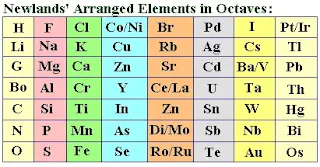
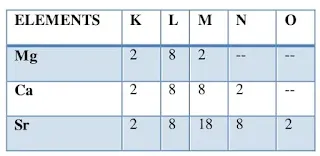
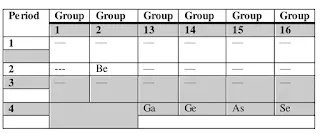
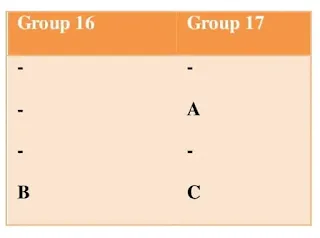
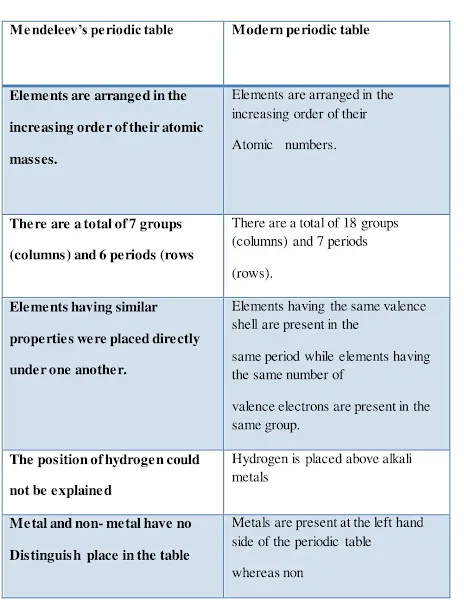




No comments:
Post a Comment